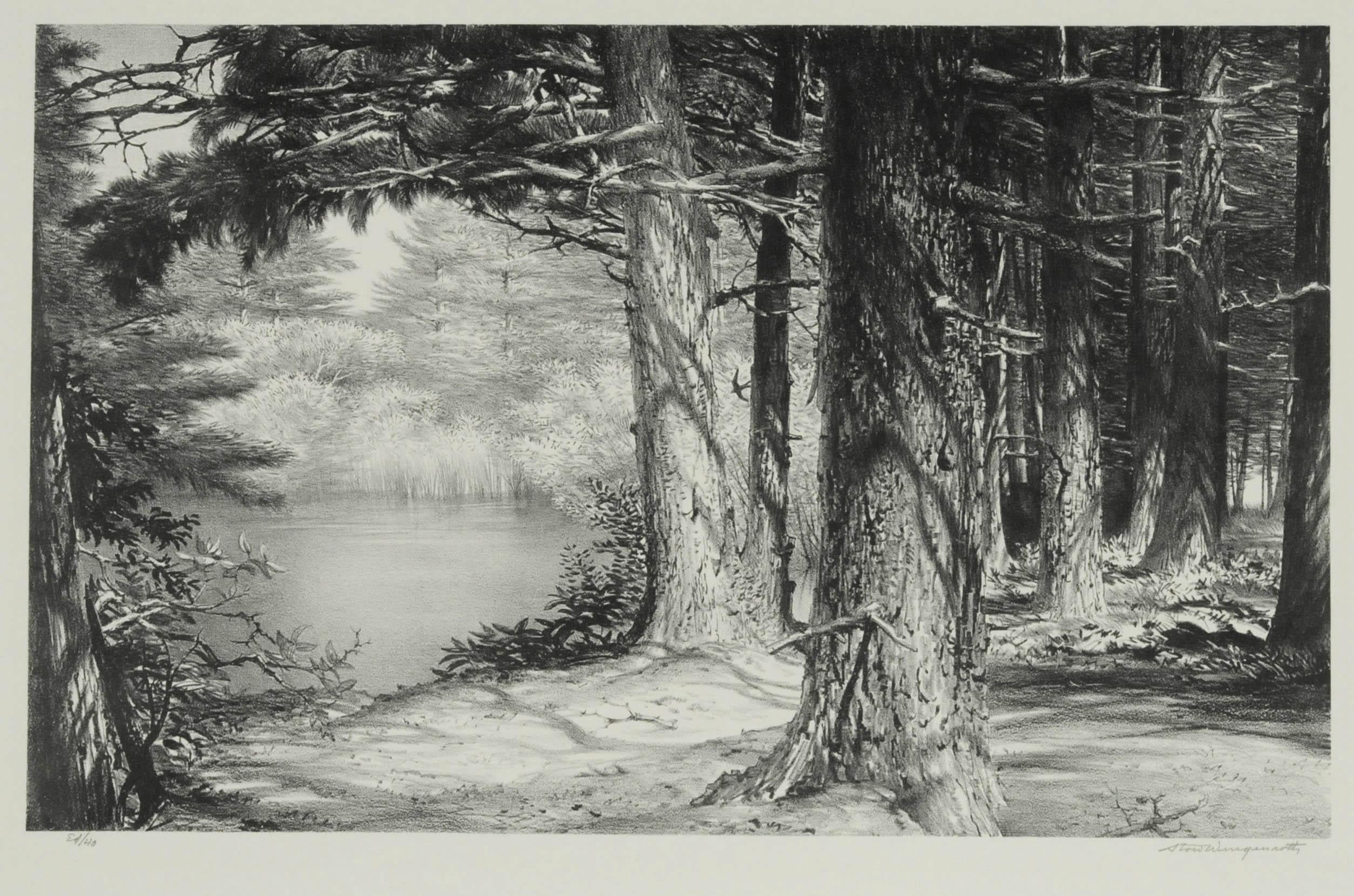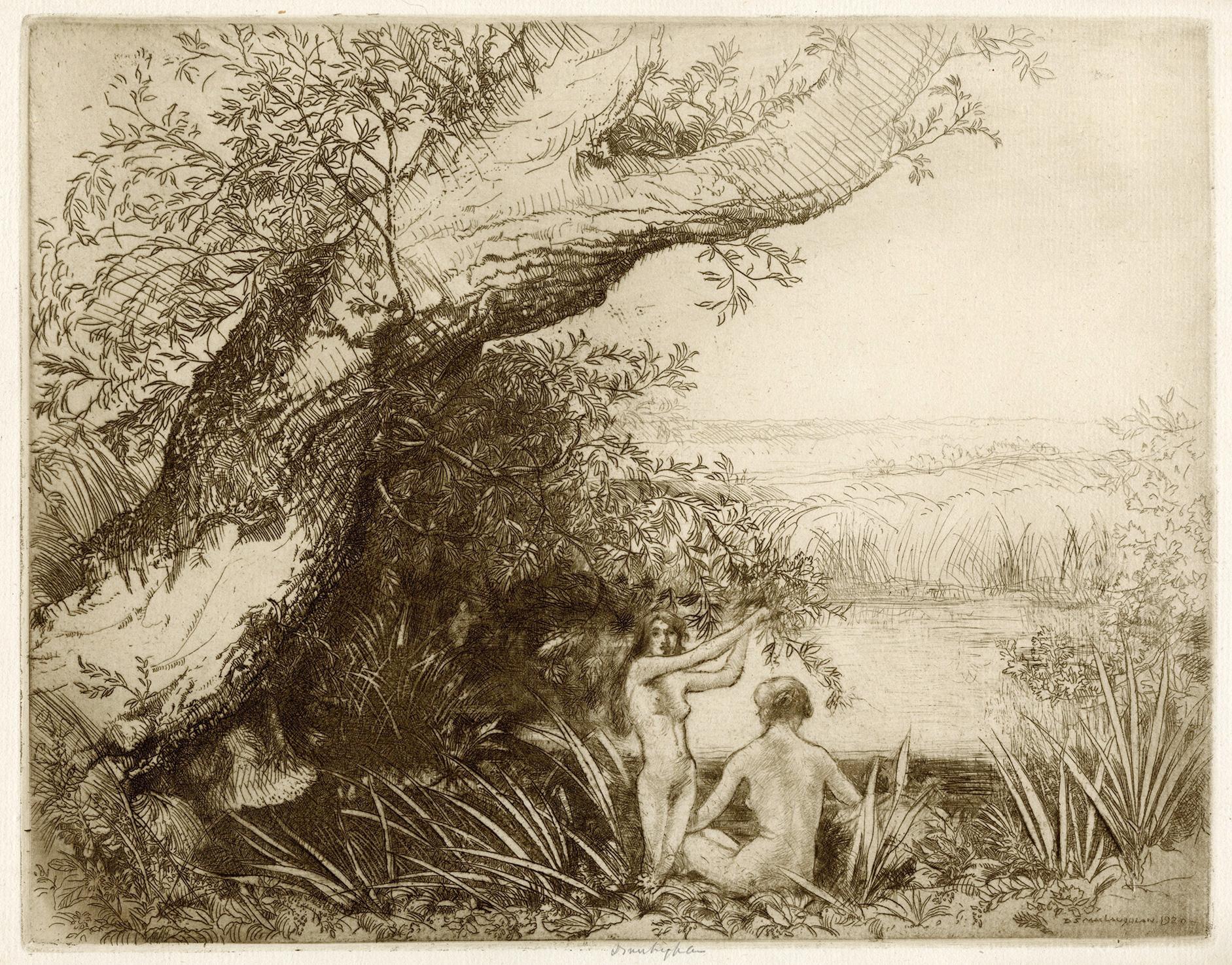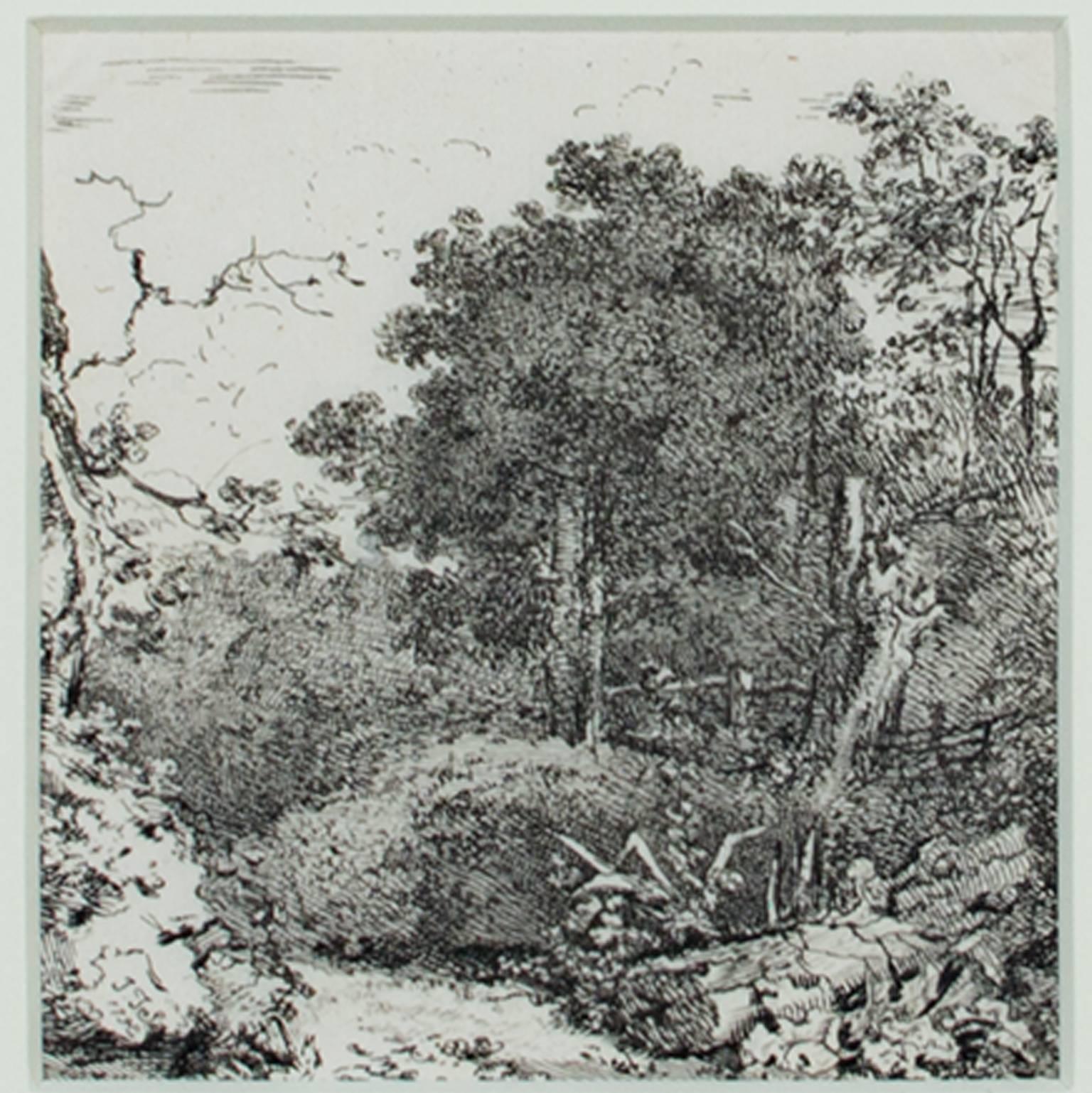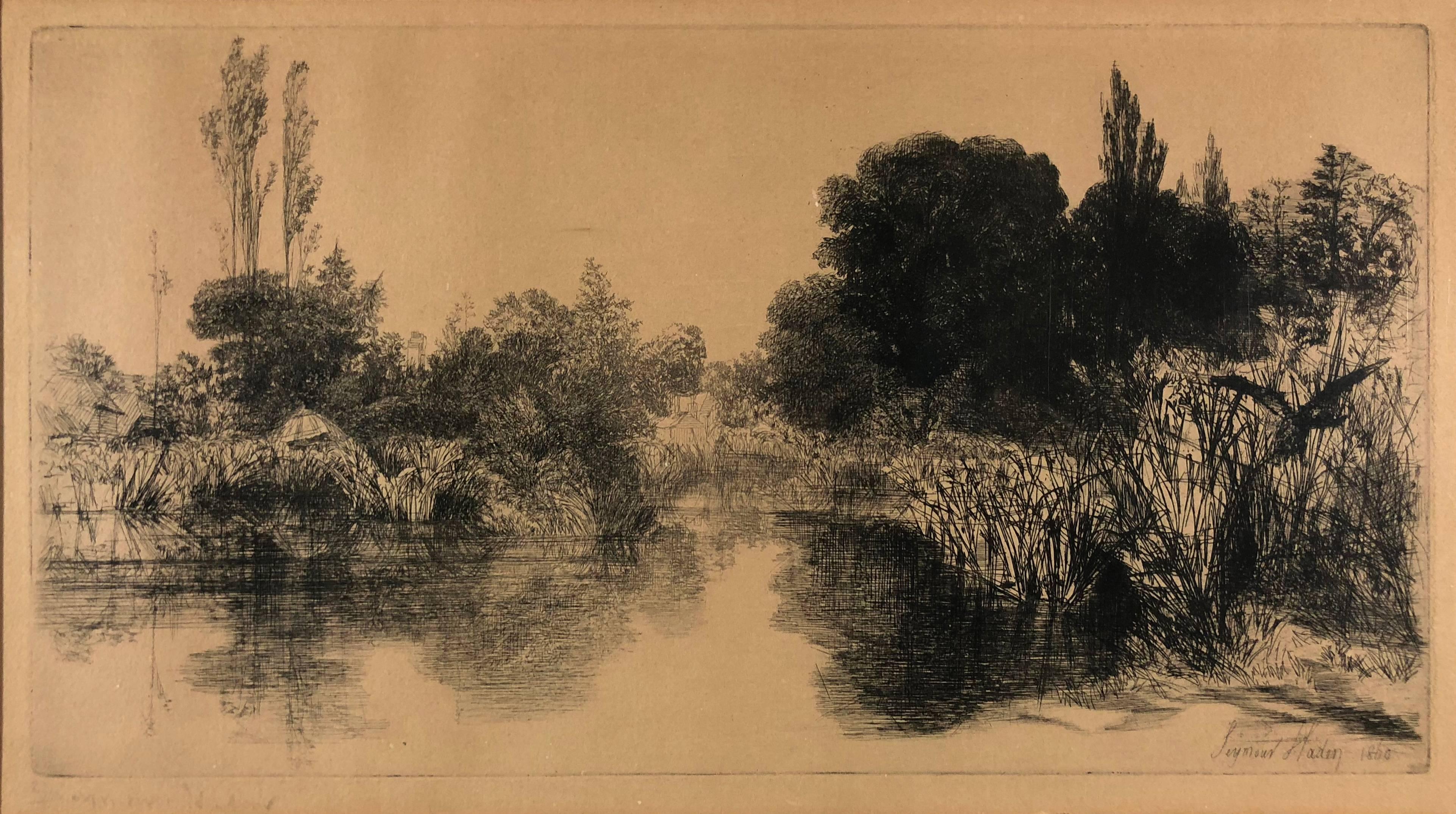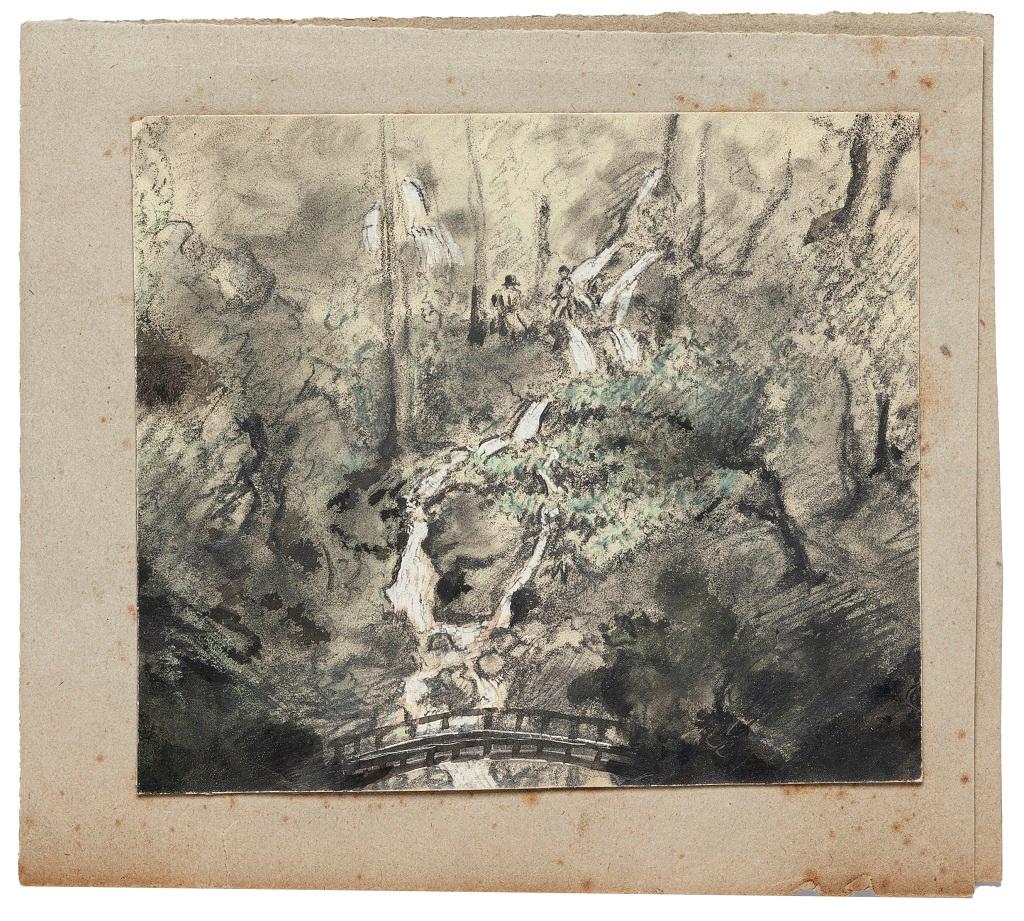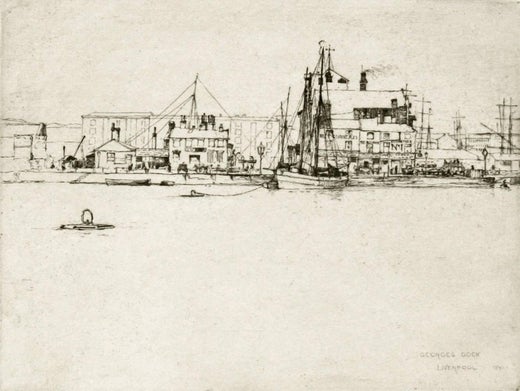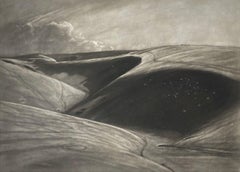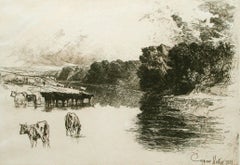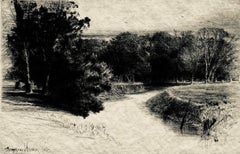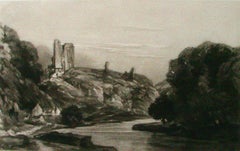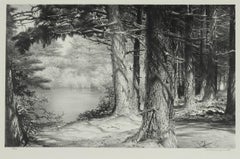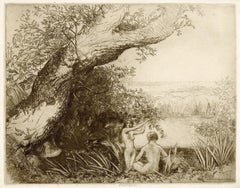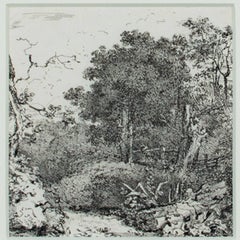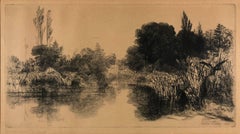Items Similar to A Yorkshire Dell or The Heron’s Pool.
Want more images or videos?
Request additional images or videos from the seller
1 of 6
Sir Frank ShortA Yorkshire Dell or The Heron’s Pool.1905
1905
$1,000
$1,25020% Off
£757.69
£947.1120% Off
€869.39
€1,086.7420% Off
CA$1,407.16
CA$1,758.9520% Off
A$1,546.86
A$1,933.5720% Off
CHF 812.96
CHF 1,016.2020% Off
MX$18,784.48
MX$23,480.6120% Off
NOK 10,141.44
NOK 12,676.8020% Off
SEK 9,608.30
SEK 12,010.3820% Off
DKK 6,488.47
DKK 8,110.5920% Off
About the Item
A Yorkshire Dell or The Heron’s Pool. (after J.M.W. Turner, R.A., 1775-1851.) Soft-ground etching and mezzotint. Hardie 85. mezzotint over etching on India paper printed on chine-collé mounted on sturdy wove paper. 10 7/8 x 15 (sheet 14 x 18 1/4). A rich, velvety impression. Signed in pencil. Houses in a 20 x 24-inch archival mat, suitable for framing.
Strange writes, "From the water-colour by J. M. W. Turner, R.A., in the collection of the late J. E. Taylor, Esq. 1905.
Mr. A J. Finberg has identified a very slight chalk sketch of this subject in a sketch-book of subjects in Scotland; so the title might be A Scottish Dell." A few proofs of the etching exist.
Sir Frank Short (1857-1945) was an English printmaker from Stourbridge, Worcestershire. He was instrumental in the revival of mezzotint and aquatint practise and was elected as the head for the department of engraving at the Royal College of Art in 1933. An ardent student of the works of J.M.W Turner; Short's reproductions of the Liber Studiorum delineate his exacting skill as well as a sympathetic study of the originals. Upon completion of Turner's most famous series, Short turned to his more esoteric material and published subjects of which the artist and his assistants had left incomplete years before. Several fine plates resulted from this study. In addition to his plaudits as a Royal Academician, Short twice won the gold medal for engraving at the Paris International Exhibition and was later knighted.
Surrounded by large rocks, and at the foot of steep banks, the focus of this image is on a pool. Behind the boulders and the shallows, a cave occupies the central plane of the composition. In the secluded dell of Turner's view, the artist does not employ human staffage. Instead, a heron emerges from the hollow between the banks and flies towards the water. In conformity with the original watercolour, Short's mezzotint is indiscriminate and impressionistic. He contorts the technique of the medium in order to produce a hazy impression suited to the representation of Turner's briars and lagoons.
- Creator:Sir Frank Short (1857 - 1945, British)
- Creation Year:1905
- Dimensions:Height: 20 in (50.8 cm)Width: 14 in (35.56 cm)Depth: 0.5 in (1.27 cm)
- Medium:
- Movement & Style:
- Period:
- Condition:
- Gallery Location:Storrs, CT
- Reference Number:1stDibs: LU33521740643
Sir Frank Short
Sir Francis Job "Frank" Short PPRE (19 June 1857 - 22 April 1945) was a British printmaker and teacher of printmaking. He revived the practices of mezzotint and pure aquatint while expanding the expressive power of line in drypoint etching and engraving. Short also wrote about printmaking to educate a wider public and was President of the Royal Society of Painter Etcher & Engravers (now styled the Royal Society of Painter-Printmakers) from 1910 to 1938. Short was elected to the Royal Academy in 1911, the same year he was knighted, and served as the R.A.'s Treasurer from 1919-1932. He was also President of the Royal Society of Painter-Etchers and Head of the Engraving School of the Royal College of Art, where he taught from 1891-1924.
About the Seller
5.0
Recognized Seller
These prestigious sellers are industry leaders and represent the highest echelon for item quality and design.
Established in 1977
1stDibs seller since 2016
725 sales on 1stDibs
Typical response time: <1 hour
Associations
International Fine Print Dealers Association
- ShippingRetrieving quote...Shipping from: Storrs, CT
- Return Policy
Authenticity Guarantee
In the unlikely event there’s an issue with an item’s authenticity, contact us within 1 year for a full refund. DetailsMoney-Back Guarantee
If your item is not as described, is damaged in transit, or does not arrive, contact us within 7 days for a full refund. Details24-Hour Cancellation
You have a 24-hour grace period in which to reconsider your purchase, with no questions asked.Vetted Professional Sellers
Our world-class sellers must adhere to strict standards for service and quality, maintaining the integrity of our listings.Price-Match Guarantee
If you find that a seller listed the same item for a lower price elsewhere, we’ll match it.Trusted Global Delivery
Our best-in-class carrier network provides specialized shipping options worldwide, including custom delivery.More From This Seller
View AllThe Shadowed Valley.
By Sir Frank Short
Located in Storrs, CT
Sir Frank Short, R.A., P.R.E. 1857-1945. The Shadowed Valley. 1927. Mezzotint. Hardie 128. 14 3/8 x 19 3/8 (sheet 19 x 24). A rich, glowing impression p...
Category
1920s Modern Landscape Prints
Materials
Mezzotint
$2,750 Sale Price
38% Off
A Lancashire River.
By Sir Francis Seymour Haden, R.A.
Located in Storrs, CT
Schneiderman 203.viii. 10 7/8 x 15 7/8 (sheet 13 7/8 x 17 7/8). Illustrated: Print Collector's Quarterly 1 (1911): 27. A 1-inch printing fold in the left-hand side of the image, and ...
Category
Late 19th Century Landscape Prints
Materials
Etching
A Sunset in Ireland.
By Seymour Haden
Located in Storrs, CT
A Sunset in Ireland. 1863. Etching and drypoint. Schneiderman catalog number 47 state vii/xiv. 5 1/2 x 8 1/2 (sheet 6 7/8 x 9 1/2). An extremely rich impression with drypoint burr, p...
Category
19th Century Modern Landscape Prints
Materials
Drypoint, Etching
$1,600 Sale Price
20% Off
Knaresborough
By Sir Frank Short
Located in Storrs, CT
Knaresborough (after a watercolor by Peter De Wint, 1784-1849). c. 1904. Mezzotint. Hardie catalog 80 state ii. 7 7/16 x 11 3/8 (sheet 13 3/8 x 18). A very rich impression, printed o...
Category
Early 1900s Impressionist Landscape Prints
Materials
Mezzotint
Alington in Wiltshire (The First Swallow).
By Robin Tanner
Located in Storrs, CT
Alington in Wiltshire (The First Swallow). 1927. Etching. Garton 2.iv. 6 3/4 x 8 7/8 (sheet 10 1/2 x 13 1/2). Final state published by in an editon of 12 by Garton & Cooke in 1982 (Nicolson published an edition of 40 in 1927). In states iii and iv, the swallow of the title was removed. In state iv, the sky was re-etched and the cross-hatching was slightly finer. Signed in pencil.
Garton writes, page 11: "The design was based on the Anglican chapel-of-ease is the farmyard of Bulisge at Allinston near Chippenham....The print was originally entitled The First Swallow, but the swallow was burnished out before the 1927 edition....Fifty years later new work was effected in the worn-out areas of the sky and distance to produce prints which, in his opinion, were better than those of the original edition."
Robin Tanner was an English artist, etcher, and printmaker. He followed the visionary tradition of Samuel Palmer and English neo-romanticism. His etchings began following night-school classes at Goldsmiths College, London. He had been inspired by the major Samuel Palmer retrospective exhibition organized by Martin Hardie...
Category
1920s Modern Landscape Prints
Materials
Etching
$1,250 Sale Price
37% Off
Water Mill
By Sir Frank Short
Located in Storrs, CT
Water Mill (after the drawing by J.M.W. Turner, R.A., 1775-1851). 1885. Mezzotint. Hardie 3.ii. With the publication line. 7 x 10 1/8 (sheet 12 1/4 x 16 5/8...
Category
1880s Animal Prints
Materials
Mezzotint
You May Also Like
Hidden Pond
By Stow Wengenroth
Located in Fairlawn, OH
Hidden Pond
Lithograph, 1958
Signed in pencil lower right of image
Annotated: Ed/40 in pencil by the artist lower left
Edition: 40
Provenance:
Baldwin-Wallace College, Berea, OH (acc...
Category
1950s American Realist Landscape Prints
Materials
Lithograph
The Enchanted Pool
By Donald Shaw MacLaughlan
Located in Middletown, NY
Etching with drypoint printed in sepia ink on cream laid paper bearing an indiscernible watermark with linked spheres. 10 1/4 x 13 1/8 inches (260 x 332 mm), unevenly trimmed yet ful...
Category
Early 20th Century English School Figurative Prints
Materials
Etching, Laid Paper, Drypoint
"Forest Glen, " Etching Landscape initialed in Plate by John Thomas Smith
By John Thomas Smith
Located in Milwaukee, WI
"Forest Glen" is an original etching by John Thomas Smith. The piece was initialed in plate. It depicts a small inlet to a lush forest.
3 5/8" x 3 1/2" art
12 7/8" x 12 3/4" frame
...
Category
1790s Old Masters Landscape Prints
Materials
Etching
Shere Mill Pond
By Sir Francis Seymour Haden, R.A.
Located in Missouri, MO
Shere Mill Pond, No. II (large plate). 1860. Etching and drypoint. Schneiderman 37.v/ix. 7 x 13 1/8 (sheet 10 3/4 x 16 3/8). This state is prior to publication in Études à l'Eau-Forte. Illustrated: Keppel The Golden Age of Engraving; Print Collector's Quarterly 1 (1911): 18; : Guichard, British Etchers, 1850-1940. A rich, brilliant proof with drypoint burr printed on white laid paper. Signed in pencil.
-------------------------------------------------------------------------------------------
Shere Mill Pond, No. II was one of the most highly praised landscape prints of the etching revival. An impression was exhibited at the Royal Academy in 1861 under Haden’s pseudonym, H. Dean. Francis Seymour Haden used this anagram of his own name early in his career as an artist, in order to retain his anonymity and preserve his professional reputation as a surgeon.
Biography:
Sir Francis Seymour Haden (16 September 1818 - 1 June 1910), was an English surgeon, best known as an etcher.
He was born in London, his father, Charles Thomas Haden, being a well-known doctor and lover of music. He was educated at Derby School, Christ's Hospital, and University College, London, and also studied at the Sorbonne, Paris, where he took his degree in 1840. He was admitted as a member of the College of Surgeons in London in 1842.
In 1843-1844, with his friends Duval, Le Cannes and Colonel Guibout, he travelled in Italy and made his first sketches from nature. Haden attended no art school and had no art teachers, but between 1845 and 1848 he studied portfolios of prints belonging to a second-hand dealer named Love, who had a shop in Bunhill Row, the old Quaker quarter of London. Arranging the prints in chronological order, he studied the works of the great original engravers, Albrecht Dürer, Lucas van Leyden and Rembrandt. These studies, besides influencing his original work, led to his important monograph on the etched work of Rembrandt. By lecture and book, and with the aid of the memorable exhibition at the Burlington Fine Arts Club in 1877, he tried to give a true reflection of Rembrandt's work, giving a nobler idea of the master's mind by taking away from the list of his works many dull and unseemly plates that had long been included in the lists. His reasons were founded upon the results of a study of the master's works in chronological order, and are clearly expressed in his monograph, The Etched Work of Rembrandt critically reconsidered, privately printed in 1877, and in The Etched Work of Rembrandt True and False (1895).
Haden's printmaking was invigorated by his much younger brother-in-law, James Whistler, at the Haden home in Sloane Street in 1855. A press was installed there and for a while Haden and Whistler collaborated on a series of etchings of the Thames. The relationship and project did not last.
Haden followed the art of original etching with such vigour that he became not only the foremost British exponent of that art but brought about its revival in England. His strenuous efforts and perseverance, aided by the secretarial ability of Sir WR Drake, resulted in the foundation of the Royal Society of Painter-Etchers and Engravers. As president he ruled the society with a strong hand from its first beginnings in 1880.
Notwithstanding his study of the old masters of his art, Haden's own plates were very individual, and are particularly noticeable for a fine original treatment of landscape subjects, free and open in line, clear and well divided in mass, and full of a noble and dignified style of his own. Even when working from a picture his personality dominates the plate, as for example in the large plate he etched after J.M.W. Turner's "Calais Pier," which is a classical example of what interpretative work can do in black and white. Of his original plates, more than 250 in number, one of the most notable was the large "Breaking up of the Agamemnon."
An early plate, rare and most beautiful, is "Thames Fisherman". "Mytton Hall" is broad in treatment, and a fine rendering of a shady avenue of yew trees leading to an old manor-house in sunlight. "Sub Tegmine" was etched in Greenwich Park in 1859; and "Early Morning--Richmond", full of the poetry and freshness of the hour, was done, according to Haden, actually at sunrise. One of the rarest and most beautiful of his plates is "A By-Road in Tipperary"; "Combe Bottom" is another; and "Shere Mill Pond" (both the small study and the larger plate), "Sunset in Ireland," "Penton Hook," "Grim Spain" and "Evening Fishing, Longparish," are also notable examples of his genius. A catalogue of his works was begun by Sir William Drake and completed by Harrington in 1880. During later years Haden began to practise the sister art...
Category
Late 19th Century Old Masters Landscape Prints
Materials
Drypoint, Etching
The Pond - Original Drawing - 1900s
Located in Roma, IT
The Pond is an original modern artwork realized in the early 20th Century.
Original drawing realized wth black pencil, charcoal and white lead. Image Dimensions: 10 x 11 cm
The sh...
Category
Early 1900s Modern Landscape Drawings and Watercolors
Materials
Charcoal, Pencil
The Heron by the River: atmospheric 19th Century Naturalist school landscape
Located in Norwich, GB
One wonderful thing about this painting is its light. It’s pitch-perfect: if it were a tad
darker, it would be gloomy; a tad lighter, and it there would be less to discover. The joy ...
Category
1860s Naturalistic Landscape Paintings
Materials
Canvas, Oil
